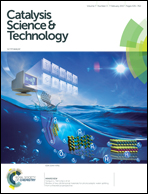Titania supported MOF-199 derived Cu–Cu2O nanoparticles: highly efficient non-noble metal photocatalysts for hydrogen production from alcohol–water mixtures†
Abstract
Fabrication of cheap and efficient photocatalysts is pivotal for practical applications of solar energy devices. Here, we illustrate a novel trend in generating Cu–Cu2O nanoparticles over TiO2 for water splitting systems. Titanium(IV) isopropoxide was hydrolysed in the presence of various wt% of MOF-199 ([Cu3(BTC)2(H2O)3]n) to obtain TiO2–MOF-199 composite materials. These composite materials are then calcined at various temperatures in air to produce highly dispersed Cu–Cu2O nanoparticles over TiO2; these nanoparticles were tested as photocatalyts for hydrogen generation from alcohol–water mixtures. The photocatalyst 1 wt% Cu/TiO2-400 was found to exhibit a hydrogen production rate some 2.5 times higher than that of CuO prepared by conventional precipitation methods. The calcination temperature of the TiO2–MOF composite was found to affect the oxidation state of Cu and the photocatalytic activity, with an optimum performance achieved at 400 °C. Calcination beyond this temperature led to oxidation and agglomeration of Cu–Cu2O nanoparticles into larger CuO deposits, which reduce the H2 production activity (ca. 80%).



 Please wait while we load your content...
Please wait while we load your content...